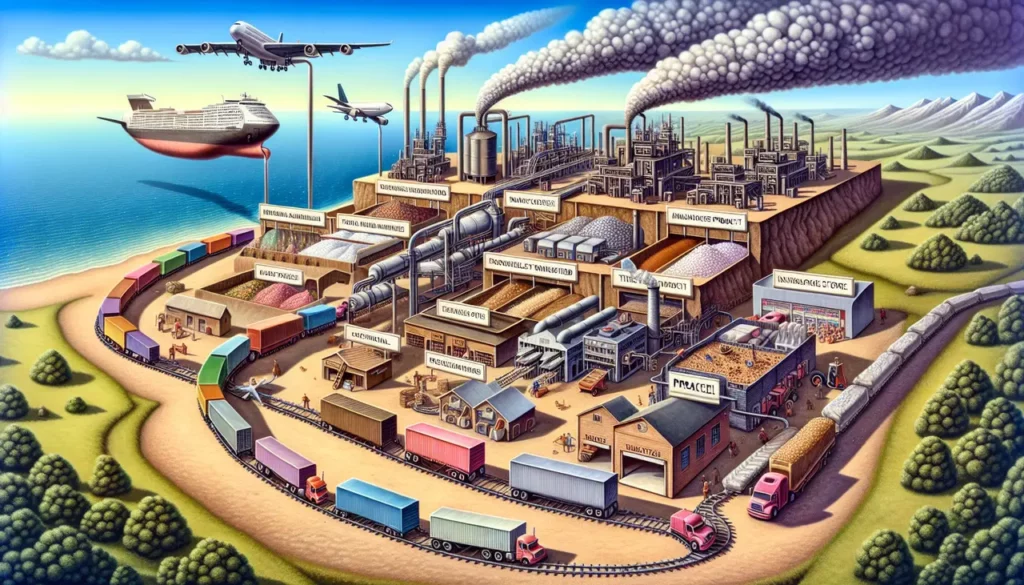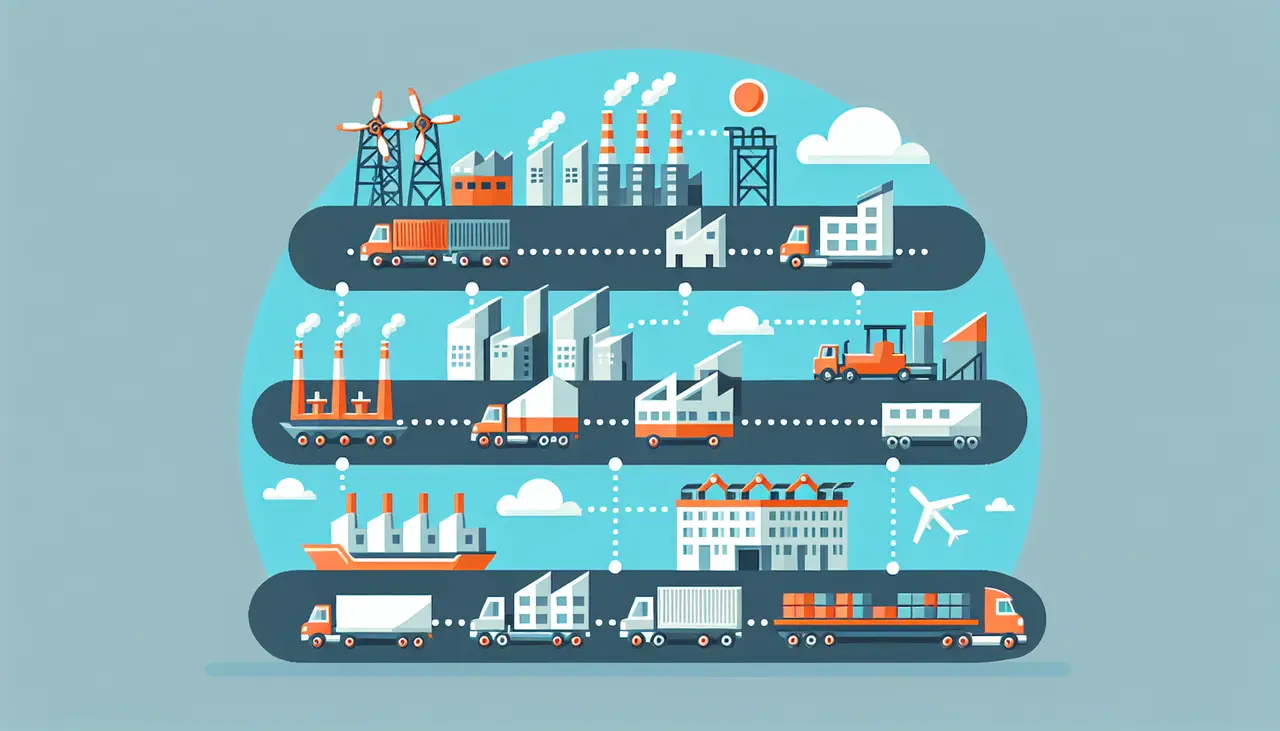Introduction to Traditional Supply Chains
Traditional supply chains are like a long road from making a product to getting it into your hands. Imagine someone grows apples. Those apples don’t go straight to you. First, they go to a place where they’re checked and packed. Next, they might go to a regional distributor, then a local store, and finally, they reach you. At each stop, people add a little to the price to make some profit. This is why by the time you buy those apples, the price is higher than what the farmer originally wanted for them. These extra steps and the added costs at each one are why things you buy can be more expensive. Traditional supply chains have a lot of players, each taking a piece of the pie, making the end product costlier for us.
The Basics of Supply Chain Management
Supply Chain Management, or SCM, is the backbone of how products get from the manufacturer to your doorstep. At its core, SCM involves handling the production, shipment, and distribution of products. Think of it as the journey a product takes from being made to being in your hands. It includes every step – from sourcing raw materials, manufacturing the goods, storing them in warehouses, moving them from place to place, to finally selling them to customers. Each step in this chain adds a bit of cost to the final price you pay. Why? Because each step involves labor, transportation, storage, and handling fees. The more complex the supply chain, the more costs are added. That’s why a simple product, which might cost pennies to make, can end up being much more expensive by the time it reaches you. Simplifying supply chains or making them more efficient is one way businesses try to keep these added costs low. But remember, every item you buy has gone on quite the journey before ending up in your shopping cart.
How Inefficiencies Creep into Supply Chains
Supply chains are complex, with each step from manufacturer to consumer adding a bit of cost due to inefficiencies. These can come from various sources. Too many middlemen, for instance, add layers of transactions, each taking a slice of the profit, pushing up the final price of products. Then, there’s the issue of outdated technology. Some companies still rely on old systems that are slow and prone to errors, leading to delays and additional costs to rectify mistakes. Poorly planned logistics is another cost inflator. When goods aren’t optimally shipped – think half-full trucks or indirect routes – it costs more in fuel, labor, and time. Stock mismanagement, either too much or too little, also plays a part. Overstock means tying up money in unused inventory, risking obsolescence or damage. Understock leads to rush orders and premium shipping costs. Each inefficiency might seem small on its own, but combined, they substantially hike up product costs before they ever reach you.
The Role of Middlemen: An Analysis
Middlemen play a crucial role in traditional supply chains, but they also add to the cost of products. Think of middlemen as the go-betweens that connect manufacturers to retailers or consumers. While they provide valuable services like distribution, storage, and sales, each middleman adds their own markup to the product’s price. Here’s the deal: when a product moves from the factory to the consumer, it often goes through distributors, wholesalers, and retailers. Each of these steps means an extra cost is tacked on. For example, a manufacturer might sell a product to a distributor at one price. The distributor then sells it to a retailer at a higher price to make a profit. Finally, the retailer sells it to you, the consumer, with an additional markup to cover their costs and profit. This chain of markups significantly inflates the final price you pay. Let’s not forget, middlemen also mean more time from production to shelf, which can impact a product’s cost and freshness, especially with perishables. In a nutshell, while middlemen are necessary for getting products to market, their series of markups contributes to higher prices for consumers.
Transportation and Logistics Costs
Transportation and logistics are big factors that push up the price of everything you buy. From the moment a product leaves the factory to when it lands in your hands, it travels a lot. Each step of the way adds costs. Trucks, ships, and planes use fuel, which isn’t cheap. Also, companies have to pay workers to move, pack, and take care of these goods. When there are delays or problems, costs go up even more. Bad weather, traffic jams, or trouble at ports can slow things down, leading to extra storage fees and rush charges to get things moving again. All these expenses get added to the final price tag of the products. In simple terms, the more a product has to travel and the more hands it passes through, the more you’ll end up paying for it.
Inventory Management and Holding Costs
Inventory management is like playing a complex game of Tetris with your products, but the stakes are real money. Every product sitting in a warehouse is cash that’s not moving. This game involves holding costs – these are the expenses related to storing unsold goods. Think rent, utilities, insurance, and salaries for workers who manage these spaces. The longer a product sits, the more money it eats up without bringing any in return.
Here’s the kicker: holding costs can represent 20% to 30% of the total inventory value on an annual basis. It’s a chunk of change, especially for small businesses. Effective inventory management aims to minimize these costs by keeping just enough stock on hand to meet demand without overloading the warehouse. It’s a delicate balance. Too much stock and you’re drowning in holding costs. Too little, and you might miss out on sales.
When supply chains are not optimized, these costs can inflate product prices. Businesses need to recover these expenses somehow, and often, it’s the customers who bear the brunt in the form of higher prices. In summary, smarter inventory management can help keep these costs in check, making products more affordable for everyone.
The Impact of Return Processes on Prices
When a product gets returned, it doesn’t just go back on the shelf. The return process can be complex and expensive, driving up the prices of goods. Returns involve shipping, handling, inspecting, and repackaging. Sometimes, products even need to be refurbished or disposed of, which costs money. These expenses add up. Retailers and manufacturers often offset these costs by charging more for products. So, when you notice price tags creeping up, remember that the hassle of returns plays a part. It highlights a cycle where goods become pricier, partly because handling returns is a costly ordeal.
Case Studies: Real-World Examples of Supply Chain Inflation
Let’s get down to brass tacks with some real-world case studies that show how traditional supply chains hike up the product costs. First off, take the electronics industry. A smartphone might start its life at a manufacturing plant in Asia, where components are sourced from various suppliers. By the time it lands in your hands in the U.S or Europe, costs have ballooned. Why? Each step in the supply chain, from factory to distributor to retailer, adds its markup. That (1,000 phone might only cost )300 to make, but transportation, tariffs, warehouse storage, and retailer margins pump up the final price like a balloon.
Next up, the fashion industry. A t-shirt that costs mere dollars to produce can end up with a price tag 5 to 10 times higher. Here’s the kicker: production might be cheap, but the numerous middlemen including brand licensing fees, import taxes, and the high cost of marketing all inflate the price before it hits the store shelves.
Food supply chains aren’t immune either. Consider the journey of a coffee bean from a farm in Ethiopia to a cafe in New York. Along the way, there are exporters, importers, roasters, and finally the cafe itself, each adding its layer of costs. By the time you sip that latte, the price is miles away from what the farmer gets paid.
In each case, the supply chain’s complexity not only makes the end product more expensive for us, the consumers, but it also can slow down delivery and reduce transparency about where and how products are made. It’s a tangled web that adds dollars to the price tags we see.
Innovative Solutions to Streamline Supply Chains
In the world of business, few things are as critical as the supply chain. It’s the backbone of how products move from creation to customer. But, traditional models are bulky, slow, and filled with unnecessary steps that hike up prices. Here’s the good part: innovative solutions are changing the game. Lean management practices strip away the fat, focusing only on what adds real value. This means cutting out pointless storage and reducing handling times. Automation brings in robots and software to do repetitive tasks faster and without errors. We’re talking about packing boxes, sorting inventory, and even forecasting demand with algorithms. Then there’s the magic of Blockchain technology. It makes every transaction crystal clear, reducing the chance of fraud and lost items. This trust boosts efficiency big time. Direct-to-consumer models are also shaking things up. By skipping the middlemen, products go straight from maker to buyer, slashing costs and wait times. What we see here are steps not just cutting corners but paving a quicker, cheaper path from production to porch. These aren’t future dreams; they’re happening right now, transforming how we get our goods in the best way possible.
Conclusion: Rethinking Supply Chain for Cost Efficiency
In wrapping up, it’s crystal clear that traditional supply chains add a hefty sum to product costs. From manufacturers to end consumers, each step piles on expenses – making goods pricier. What’s needed now is a shift towards more efficient supply chain models. By cutting out unnecessary middlemen, embracing technology, and refining logistics, costs can significantly drop. This not only makes products more affordable for consumers but also enhances the overall efficiency of businesses. The key takeaway? It’s high time for companies to rethink and remodel their supply chains for cost efficiency and competitive edge.


